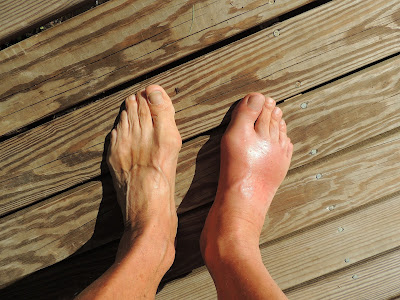Peripheral Edema: Causes and Treatment
Swelling or edema of legs, ankles and feet is common. There are a wide range of disorders which are responsible for edema of legs, ankles and feet. Some may be harmless for example activities that require standing for long duration and some may be serious like congestive heart failure.
Research suggests that edema affects many individuals, including those with obesity, older age, sedentary lifestyles, history of deep venous thrombosis, and occupations that require long hours of standing.
There are many types of edema clinically. Edema can be classified basis on the location, puffiness and the constituents of the fluid (venous or lymphatic). This article is focused on the edema/swelling of the legs, ankle and feet. This is called peripheral edema of the lower limb.
What is edema?
Edema is characterised by excessive accumulation of fluid in the interstitial space. It occurs when capillary filtration is more than the lymphatic drainage.
In general, the lymph flow is maintained by two factors in our body. One is extrinsic force and the other is intrinsic force. The extrinsic forces are produced by the contraction of skeletal muscles which are situated adjacent to the lymphatic vessels. Cardiac and arterial pulsations, respiration, and central venous pressure fluctuations also influence the extrinsic forces. Alternatively, the intrinsic force is generated by spontaneous contraction of lymphatic muscles. The combined extrinsic and intrinsic forces can transport lymph via lymphatic vessels against hydrostatic pressure in the legs.
The lymph flows in lymphatic vessels and does not come out in the interstitial space in excess quantity. Even if it comes into interstitial space it is pumped back into normal lymph flow as explained above. However, any disruption in the lymph flow due to any reason can cause accumulation of excess amount of fluid in interstitial space resulting in oedema/swelling or more precisely called peripheral edema.
Peripheral edema is most commonly seen in legs, ankle and feet. However, hands and face are other areas where peripheral edema may be observed.
Causes of Peripheral Edema
 |
| Peripheral Edema Causes |
Systemic Causes:
- Liver cirrhosis
- Congestive heart failure
- Pericarditis
- Scleroderma
- Pulmonary Hypertension
- Renal failure
- Hypoproteinemia
- Pregnancy
- Obesity
- Hormones
Localised Causes:
- Infection
- Trauma such as sprain, strain and fracture etc.
- Chronic venous insufficiency
- Lymphatic dysfunction
Drug Induced:
- Anti-hypertensive drugs such as Beta blockers, Clonidine, Hydralazine etc.
- Prednisone
- Anti-inflammatory drugs
Other Causes:
- Diet – Too much salt consumption can lead to edema. Low protein diet can cause hypoalbuminemia which in turn results in edema.
- Long periods of standing/sitting postures
Diagnosis:
The swelling of legs, ankle and feet is generally very visible. However, a complete physical examination is required to find out the exact cause of the edema. Diagnostic test such as x-rays, MRI, ultrasound, and Doppler and lab investigation helps in to find out accurate cause of the edema.
Sign and Symptoms:
Three major sign and symptoms of Peripheral Edema are as follows:
- The swelling may be asymptomatic however localised pain, ache and tenderness are also features of peripheral edema.
- Heaviness, weakness and discomfort of the affected limb is also seen.
- Limitations in mobility and flexibility: People with peripheral edema may face difficulties in performing their activities of daily living such as walking, running, stair climbing and cycling. The leisure activities such as swimming, dancing, gardening, horse riding and sailing are also challenging task for these individuals.
Prevention and Treatment:
Here are 9 effective management tips for Peripheral Edema:
- Take a break from prolonged sitting or standing position. Move around and perform ankle pump exercise.
- Avoid hanging the legs while sitting. Use any support to put your feet on this when long sitting is required.
- Elevation – The affected legs need to be elevated above the level of heart. It can be performed few times a day. You can also perform ankle pump exercise in this position. It will enhance the lymphatic flow and reduce the edema. Sleeping with a pillow under the legs at night is also helpful.
- Exercise – Walking, cycling and running can strengthen the calf muscle which is helpful in appropriate circulation of fluid. However, these should not be done for a longer duration. Remember long duration of standing and sitting position are also one of the causative factors of peripheral edema. Rapid back and forth movement of ankle is advisable. This is called ankle pump exercise and should be performed in supine lying position.
- Wear compression bandages on the affected legs, if required.
- Scope of diet modification should be evaluated. Cut down the salt consumption and increase protein rich diet.
- Gentle massage of the affected leg to push fluid in the direction of the heart may be helpful. However, massage is contradictory in patients with deep vein thrombosis.
- Weight loss strategies should be adopted to lose weight if you’re overweight.
- Management of underlying disease or causative factor as advised by doctor.
Though swelling of ankle and feet seems very normal to occur however, it indicates that there is imbalance in the fluid flow. Peripheral edema can be temporary (as in injury, trauma or allergy) or it can be permanent (as in hormonal changes). Also, sustained swelling may increase risk of deep vein thrombosis. Therefore, a thorough examination should be conducted on regular basis to avoid any complication.
You May Also Like:





This is so interesting! I get fluid build up around my ankles but seems constant and no pain so always wondered what it was. Will try these tips and see if they help!
ReplyDeleteThis is a very educatinal post. I know many pregnant women experience edema. I appreciate you sharing the difference disease states that may contribute to Edema. KEVIN FOODIE- www.food-explora.com
ReplyDeleteGreat post. Those of us with chronic illnesses recognize this foe. I hope to get an answer on the root cause soon.
ReplyDelete